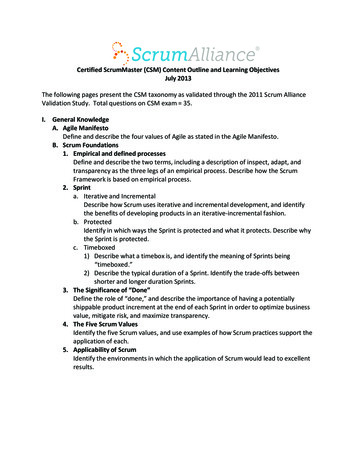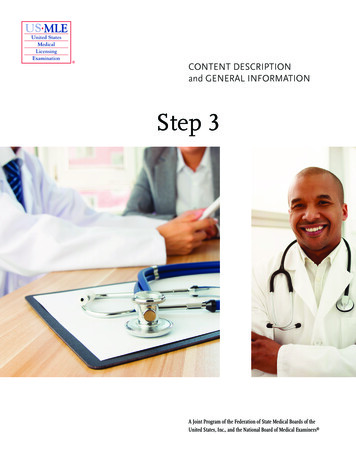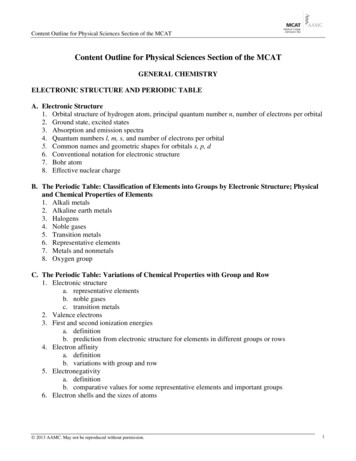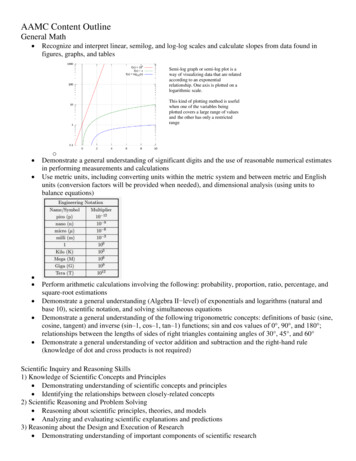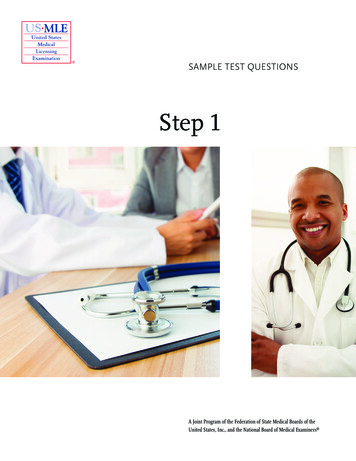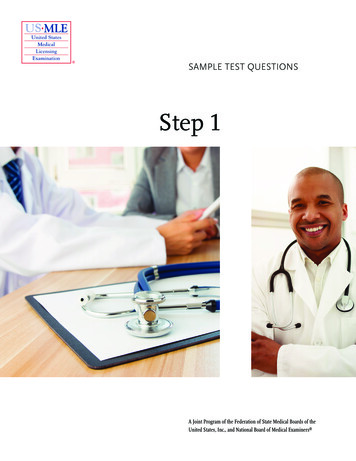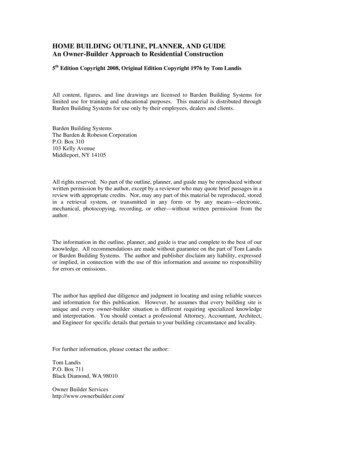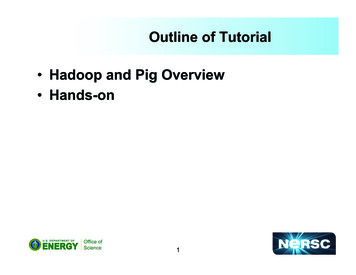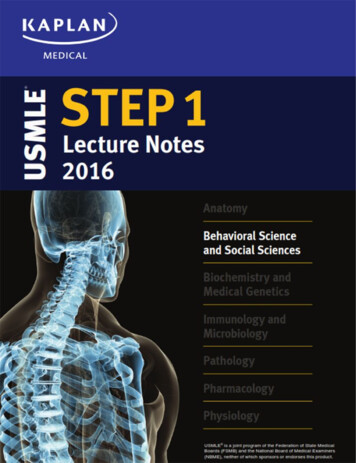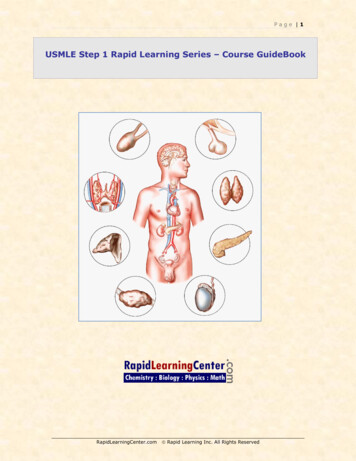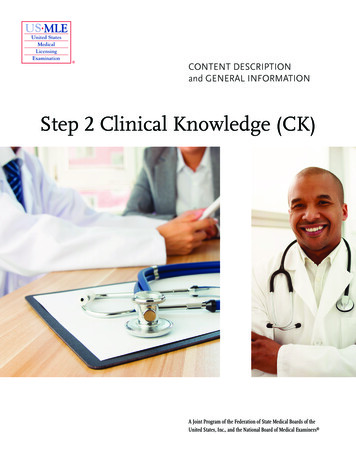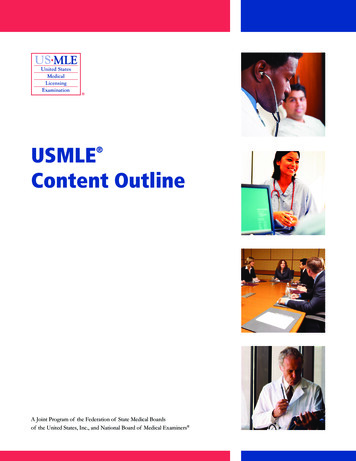
Transcription
USMLEContent Outline A Joint Program of the Federation of State Medical Boardsof the United States, Inc., and National Board of Medical Examiners
This outline provides a common organization of content across all USMLE examinations. Each Step exam willemphasize certain parts of the outline, and no single examination will include questions on all topics in the outline.The examples listed within the outline are just examples. Questions may include diseases, symptoms, etc., that arenot included in the outline. The USMLE program continually reviews its examinations to ensure their content isrelevant to the practice of medicine. As practice guidelines evolve or are introduced, the content on USMLE isreviewed and modified as needed. At times, there is a change in emphasis on new content development that arisesfrom our ongoing peer-review processes. For example, there has been an emphasis on new content developedassessing competencies related to geriatric medicine, and prescription drug use and abuse. USMLE has also focusedrecent efforts on the often unrecognized health care needs of recently returning servicemen and servicewomen (eg,traumatic brain injury and post-traumatic stress disorder), and the families of deployed servicemen andservicewomen. While many of the medical issues related to the health care of these special populations are notunique, certain medical illnesses or conditions are either more prevalent, have a different presentation, or aremanaged differently. Knowledge of foundational science and clinical science in these content areas will be assessedon the USMLE Step 1, Step 2 CK, and Step 3 examinations.Examinees should refer to the test specifications for each examination for more information about whichparts of the outline will be emphasized in the examination for which they are preparing. See the USMLE website(www.usmle.org) for more detail.Copyright 2020 by the Federation of State Medical Boards of the United States, Inc. (FSMB)and National Board of Medical Examiners (NBME ). All rights reserved. The United StatesMedical Licensing Examination (USMLE ) is a joint program of the FSMB and NBME.FOR PUBLIC RELEASE
Table of ContentsGeneral Principles of Foundational Science2Immune System4Blood & Lymphoreticular System5Behavioral Health7Nervous System & Special Senses8Skin & Subcutaneous Tissue11Musculoskeletal System12Cardiovascular System13Respiratory System15Gastrointestinal System16Renal & Urinary System18Pregnancy, Childbirth, & the Puerperium20Female Reproductive System & Breast21Male Reproductive System22Endocrine System23Multisystem Processes & Disorders24Biostatistics, Epidemiology/Population Health, &Interpretation of the Medical Literature27Social Sciences291
General Principles of Foundational ScienceBiochemistry and molecular biologyGene expression: DNA structure, replication, exchange, and epigenetics (eg, imprinting, Xactivation, DNA methylation)Gene expression: transcriptionGene expression: translation, post-translational processing, modifications, and disposition ofproteins (degradation), including protein/glycoprotein synthesis, intra-extracellularsorting, and processes/functions related to Golgi complex and rough endoplasmicreticulumStructure and function of proteins and enzymes (eg, enzyme kinetics andstructural/regulatory proteins)Energy metabolism (eg, ATP generation, transport chain)Biology of cellsAdaptive cell responses and cellular homeostasis (eg, hypertrophy)Mechanisms of injury and necrosis, including pathologic processes (eg, liquefactive necrosis,free radical formation)ApoptosisCell cycle and cell cycle regulation (eg, mitosis)Mechanisms of dysregulationcell biology of cancer (eg, role of p53, proto-oncogenes)general principles of invasion and metastasis, including cancer stagingCell/tissue structure, regulation, and function, including cytoskeleton, organelles,glycolipids, channels, gap junctions, extracellular matrix, and receptorsHuman development and geneticsPrinciples of pedigree analysisinheritance patternsoccurrence and recurrence risk determinationPopulation genetics: Hardy-Weinberg law, founder effects, mutation-selection equilibriumPrinciples of gene therapyGenetic testing and counselingGenetic mechanisms (eg, penetrance, genetic heterogeneity)Biology of tissue response to diseaseAcute inflammatory responses (patterns of response)acute inflammation and mediator systems (eg, histamine, prostaglandins, bradykinins,eosinophilic basic protein, nitric oxide)vascular response to injury, including mediatorsprinciples of cell adherence and migration (eg, ECAMs, selectins, leukocyticdiapedesis, and rolling)microbicidal mechanisms and tissue injury (eg, defensins)clinical manifestations (eg, pain, fever, leukocytosis, leukemoid reaction, chills)Chronic inflammatory responses (eg, tumor necrosis factor)Reparative processeswound healing, repair: thrombosis, granulation tissue, angiogenesis, fibrosis,scar/keloid formationregenerative processPharmacodynamic and pharmacokinetic processes: general principlesPharmacokinetics: absorption, distribution, metabolism, excretion, dosage intervalsMechanisms of drug action, structure-activity relationships (eg, anticancer drugs)2
Concentration and dose-effect relationships (eg, efficacy, potency), types of agonists (eg,full, partial, inverse) and antagonists and their actionsIndividual factors altering pharmacokinetics and pharmacodynamics (eg, age, gender,disease, tolerance, compliance, body weight, metabolic proficiency,pharmacogenetics)Mechanisms of drug adverse effects, overdosage, toxicologyMechanisms of drug interactionsSignal transduction, including structure/function of all components of signal transductionpathways such as receptors, ligands (eg, general principles of nitric oxide, autocrineand paracrine signaling)Microbial biologyMicrobial identification and classification, including principles, microorganismidentification, and non-immunologic laboratory diagnosisBacteriastructure (eg, cell walls, composition, appendages, virulence factors, extracellularproducts, toxins, mechanism of action of toxins)processes, replication, and genetics (eg, metabolism, growth, and regulation)oncogenesisantibacterial agents (eg, mechanisms of action on organism, toxicity to humans, andmechanisms of resistance)Virusesstructure (eg, physical and chemical properties, virulence factors)processes, replication, and genetics (eg, life cycles, location of virus in latent infection)oncogenesisantiviral agents (eg, mechanisms of action on virus, toxicity to humans, andmechanisms of resistance)Fungistructure (eg, cell wall, composition, appendages, virulence factors, extracellularproducts, toxins, mechanisms of action of toxins)processes, replication, and genetics (eg, asexual vs. sexual, metabolism, growth)antifungal agents (eg, mechanisms of action on fungus, toxicity to humans, andmechanisms of resistance)Parasitesstructure (eg, appendages, macroscopic features, and virulence factors)processes, replication, and genetics (eg, life cycles, metabolism, and growth)oncogenesisantiparasitic agents (eg, mechanisms of action on parasite, toxicity to humans, andmechanisms of resistance)PrionsNormal age-related findings and care of the well patientInfancy and childhood (0-12 years)Normal physical changes: linear growth, variations in linear growth, includingconstitutional delay; weight; head circumference; micturition, defecation, primaryincontinence/bedwetting; normal physical examination; screening; sleep;teething syndromeDevelopmental stages: motor; speech; cognitive; psychosocial; anticipatory guidanceLifestyle and routine preventive health care: nutrition; exercise (eg, benefits ofexercise); preventive/travel medicine; risk factors and prevention (eg, guns,swimming, motor vehicles, car seats); routine vaccinations3
Adolescence (13-17 years)Normal physical changes: linear growth, variations in linear growth includingconstitutional delay; weight; puberty; normal physical examination; gynecomastia;autonomy/self-identity; sleepDevelopmental stages: cognitive (eg, abstract thought); psychosocial (eg, autonomy, roleconfusion, sexual identity); anticipatory guidanceLifestyle and routine preventive health care: nutrition; exercise (eg, benefits ofexercise); preventive/travel medicine; risk factors and prevention (eg, risk-takingbehavior, helmets, safe sex, motor vehicles, seat belts, distractions); routinevaccinationsAdulthood (18-64 years)Normal physical changes: weight; normal physical examination; screening; sleepDevelopmental stages: cognitive; intimacy vs isolation; anticipatory guidanceLifestyle and routine preventive health care: nutrition; exercise (eg, benefits ofexercise); preventive/travel medicine; risk factors and prevention; routinevaccinationsSenescence (65 years and older)Normal physical changes, including normal physical exam for age: weight, height(spinal compression), skin, bruising; normal physical examination; response totemperature; micturition, defecation; sleepDevelopmental stages: motor; cognitive (eg, psychomotor slowing); psychosocial;integrity vs despair; retrospection; anticipatory guidanceLifestyle and routine preventive health care: nutrition; exercise (eg, benefits of exercise);preventive/travel medicine; risk factors and prevention (eg, falls, general medicalcondition; polypharmacy, driving, caregiver stress); routine vaccinationsImmune SystemNormal processesDevelopment of cells of the adaptive immune response, including positive andnegative selection during immune developmentStructure, production, and functiongranulocytes, natural killer cells, macrophages, mast cells, dendritic cells, cell receptors(eg, complement receptors and toll-like receptors), cytokines, chemokinesT lymphocytes, including T-lymphocyte receptors, accessory molecules (eg, CD3, CD4,CD8, B7), cell activation and proliferation, cytotoxic T lymphocytes, and memory TlymphocytesB lymphocytes and plasma cells, including B-lymphocyte receptors, immunoglobulins, cellactivation and proliferation, including development of antibodies and memory Blymphocyteshost defense mechanisms, host barriers to infection, mucosal immunity (eg, gutassociated lymphoid tissue and bronchus-associated lymphoid tissue),anatomical locations of T and B lymphocytesCellular basis of the immune response and immunologic mediatorsantigen processing and presentation in the context of MHC I and MHC II molecules (eg,TAP, beta-2 microglobulin), intracellular pathways, mechanisms by which MHC isexpressed on the surface; including distribution of MHC I and MHC II on differentcells, mechanisms of MHC I and MHC II deficiencies, and the genetics of MHCregulation of the adaptive immune response (eg, peripheral tolerance, anergy,4
regulatory T lymphocytes, termination of immune response, and B-T lymphocyteinteractions)activation, function, and molecular biology of complement (eg, anaphylatoxins)functional and molecular biology of cytokines (eg, IL 1-15)Basis of immunologic diagnostics (eg, antigen-antibody reactions used for diagnosticpurposes, ELISA, immunoblotting, antigen-antibody changes over time, ABO typing)Principles of immunologic protectionvaccine production and mechanisms of vaccine actionbiologically active antibodies (eg, monoclonal antibodies, polyclonal antibodiesincluding IVIG, VZIG, rabies immunoglobulin)Effect of age on the function of components of the immune systemAbnormal Processes: Health and Health Maintenance, Screening, Diagnosis,Management, Risks, PrognosisDisorders associated with immunodeficiencydeficiency primarily of humoral immunity: common variable immunodeficiency;hyper IgM syndrome; hypogammaglobulinemia/agammaglobulinemia, X-linked(Bruton); selective immunodeficiency (eg, IgA, IgM, IgE)deficiency/dysfunction primarily of cell-mediated immunity: adenosine deaminasedeficiency; thymic aplasia (DiGeorge syndrome); severe combined immunodeficiencydisease (SCID); Wiskott-Aldrich syndrome; granulomatosis; allergic reactions/skincomplement deficiency: alternative pathway component deficiency (C2, C3b, C3bB,C36B6); classical pathway component deficiency (C1q, C1r, C1-C5); terminalcomponent deficiency (C5b-C9; terminal complement complex); C1 esterase inhibitordeficiency, hereditary angioedema; mannose-binding lectin (MBL) deficiency;membrane attack complex deficiencydeficiency of phagocytic cells and natural killer cells: Chediak-Higashi disease; chronicgranulomatous disease and other disorders of phagocytosis; leukocyte adhesiondeficiencyHIV/AIDS: HIV1 and HIV2; AIDS; AIDS complications (eg, neuropathy, dementia, renalinsufficiency); immunology of AIDS; immune reconstitution syndrome (IRS);secondary infections; noninfectious complicationsImmunologically mediated disordershypersensitivity reactions: type 1, 2, 3, including anaphylaxis; type 4; drug reactions;serum sicknesstransplantation: rejection; graft-vs-host diseaseAdverse effects of drugs on the immune system: Jarisch-Herxheimer reaction; drugsaffecting the immune system (eg, prednisone, azathioprine, cyclosporine, methotrexate,monoclonal antibody drugs [eg, abciximab, adalimumab; bevacizumab, infliximab,omalizumab, rituximab]); vaccine adverse effectsBlood & Lymphoreticular SystemNormal ProcessesEmbryonic development, fetal maturation, and perinatal changes Organstructure and functionCell/tissue structure and functionproduction and function of erythrocytes, including heme and hemoglobin synthesis;hemoglobin O2 and CO2 transport, transport proteins, erythropoietinproduction and function of platelets5
production and function of coagulation and fibrinolytic factors; hemostasisRepair, regeneration, and changes associated with stage of lifeAbnormal Processes: Health and Health Maintenance, Screening, Diagnosis,Management, Risks, PrognosisInfectious and immunologicinfectious disordersbacteriaviral: hemorrhagic fever (Ebola virus, Marburg virus); chikungunya; dengue fever;Zika virus diseaseparasitic: malaria (Plasmodiu
on the USMLE Step 1, Step 2 CK, and Step 3 examinations. Examinees should refer to the test specifications for each examination for more information about which parts of the outline will be emphasized in the examination for which they are preparing. See
